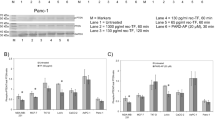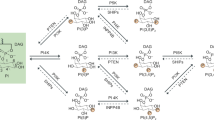Abstract
The tumor suppressor activity of PTEN (phosphatase and tensin homolog deleted on chromosome 10) is thought to be largely attributable to its lipid phosphatase activity. PTEN dephosphorylates the lipid second messenger phosphatidylinositol 3,4,5-trisphosphate to directly antagonize the phosphoinositide 3-kinase-Akt pathway and prevent the activating phosphorylation of Akt. PTEN has also other proposed mechanisms of action, including a poorly characterized protein phosphatase activity, protein–protein interactions, as well as emerging functions in different compartment of the cells such as nucleus and mitochondria. We show here that a fraction of PTEN protein localizes to the endoplasmic reticulum (ER) and mitochondria-associated membranes (MAMs), signaling domains involved in calcium (2+) transfer from the ER to mitochondria and apoptosis induction. We demonstrate that PTEN silencing impairs ER Ca2+ release, lowers cytosolic and mitochondrial Ca2+ transients and decreases cellular sensitivity to Ca2+-mediated apoptotic stimulation. Specific targeting of PTEN to the ER is sufficient to enhance ER-to-mitochondria Ca2+ transfer and sensitivity to apoptosis. PTEN localization at the ER is further increased during Ca2+-dependent apoptosis induction. Importantly, PTEN interacts with the inositol 1,4,5-trisphosphate receptors (IP3Rs) and this correlates with the reduction in their phosphorylation and increased Ca2+ release. We propose that ER-localized PTEN regulates Ca2+ release from the ER in a protein phosphatase-dependent manner that counteracts Akt-mediated reduction in Ca2+ release via IP3Rs. These findings provide new insights into the mechanisms and the extent of PTEN tumor-suppressive functions, highlighting new potential strategies for therapeutic intervention.
Similar content being viewed by others
Log in or create a free account to read this content
Gain free access to this article, as well as selected content from this journal and more on nature.com
or
Abbreviations
- ArA:
-
arachidonic acid
- [Ca2+]c:
-
cytosolic [Ca2+]
- [Ca2+]er:
-
endoplasmic reticulum [Ca2+]
- [Ca2+]m:
-
mitochondrial [Ca2+]
- cytAEQ:
-
cytosolic aequorin
- ER:
-
endoplasmic reticulum
- erAEQ:
-
endoplasmic reticulum-targeted mutated aequorin
- ER-RFP:
-
endoplasmic reticulum-targeted red fluorescent protein
- GFP:
-
green fluorescent protein
- IP3R:
-
inositol 1,4,5-trisphosphate receptor
- MAMs:
-
mitochondria-associated membranes
- mtAEQ:
-
mitochondria-targeted aequorin
- mtDsRED:
-
mitochondria-targeted red fluorescent protein
- OMM:
-
outer mitochondrial membrane
- PI3K:
-
phosphoinositide 3-kinase
- PIP3:
-
phosphatidylinositol 3,4,5-trisphosphate
- PK:
-
proteinase K
- PTEN:
-
phosphatase and tensin homolog deleted on chromosome 10
- siRNA:
-
small interfering RNA
- XeC:
-
xestospongin C
References
Salmena L, Carracedo A, Pandolfi PP . Tenets of PTEN tumor suppression. Cell 2008; 133: 403–414.
Eng C . PTEN: one gene, many syndromes. Hum Mutat 2003; 22: 183–198.
Maehama T, Dixon JE . The tumor suppressor, PTEN/MMAC1, dephosphorylates the lipid second messenger, phosphatidylinositol 3,4,5-trisphosphate. J Biol Chem 1998; 273: 13375–13378.
Myers MP, Stolarov JP, Eng C, Li J, Wang SI, Wigler MH et al. P-TEN, the tumor suppressor from human chromosome 10q23, is a dual-specificity phosphatase. Proc Natl Acad Sci USA. 1997; 94: 9052–9057.
Stambolic V, Suzuki A, de la Pompa JL, Brothers GM, Mirtsos C, Sasaki T et al. Negative regulation of PKB/Akt-dependent cell survival by the tumor suppressor PTEN. Cell 1998; 95: 29–39.
Chalhoub N, Baker SJ . PTEN and the PI3-kinase pathway in cancer. Annu Rev Pathol 2009; 4: 127–150.
Tamura M, Gu J, Matsumoto K, Aota S, Parsons R, Yamada KM . Inhibition of cell migration, spreading, and focal adhesions by tumor suppressor PTEN. Science 1998; 280: 1614–1617.
Raftopoulou M, Etienne-Manneville S, Self A, Nicholls S, Hall A . Regulation of cell migration by the C2 domain of the tumor suppressor PTEN. Science 2004; 303: 1179–1181.
Okumura K, Zhao M, Depinho RA, Furnari FB, Cavenee WK . Cellular transformation by the MSP58 oncogene is inhibited by its physical interaction with the PTEN tumor suppressor. Proc Natl Acad Sci USA. 2005; 102: 2703–2706.
Funamoto S, Meili R, Lee S, Parry L, Firtel RA . Spatial and temporal regulation of 3-phosphoinositides by PI 3-kinase and PTEN mediates chemotaxis. Cell 2002; 109: 611–623.
Shen WH, Balajee AS, Wang J, Wu H, Eng C, Pandolfi PP et al. Essential role for nuclear PTEN in maintaining chromosomal integrity. Cell 2007; 128: 157–170.
Song MS, Carracedo A, Salmena L, Song SJ, Egia A, Malumbres M et al. Nuclear PTEN regulates the APC-CDH1 tumor-suppressive complex in a phosphatase-independent manner. Cell 2011; 144: 187–199.
Zhu Y, Hoell P, Ahlemeyer B, Krieglstein J . PTEN: a crucial mediator of mitochondria-dependent apoptosis. Apoptosis 2006; 11: 197–207.
Zu L, Zheng X, Wang B, Parajuli N, Steenbergen C, Becker LC et al. Ischemic preconditioning attenuates mitochondrial localization of PTEN induced by ischemia-reperfusion. Am J Physiol Heart Circ Physiol 2011; 300: H2177–H2186.
Pinton P, Giorgi C, Siviero R, Zecchini E, Rizzuto R . Calcium and apoptosis: ER-mitochondria Ca2+ transfer in the control of apoptosis. Oncogene 2008; 27: 6407–6418.
Roderick HL, Cook SJ . Ca2+ signalling checkpoints in cancer: remodelling Ca2+ for cancer cell proliferation and survival. Nat Rev Cancer 2008; 8: 361–375.
Bononi A, Missiroli S, Poletti F, Suski JM, Agnoletto C, Bonora M et al. Mitochondria-Associated Membranes (MAMs) as Hotspot Ca(2+) Signaling Units. Adv Exp Med Biol 2012; 740: 411–437.
Wieckowski MR, Giorgi C, Lebiedzinska M, Duszynski J, Pinton P . Isolation of mitochondria-associated membranes and mitochondria from animal tissues and cells. Nat Protoc 2009; 4: 1582–1590.
Giorgi C, Ito K, Lin HK, Santangelo C, Wieckowski MR, Lebiedzinska M et al. PML regulates apoptosis at endoplasmic reticulum by modulating calcium release. Science 2010; 330: 1247–1251.
Pinton P, Rimessi A, Romagnoli A, Prandini A, Rizzuto R . Biosensors for the detection of calcium and pH. Methods Cell Biol 2007; 80: 297–325.
Trotman LC, Wang X, Alimonti A, Chen Z, Teruya-Feldstein J, Yang H et al. Ubiquitination regulates PTEN nuclear import and tumor suppression. Cell 2007; 128: 141–156.
Scorrano L, Oakes SA, Opferman JT, Cheng EH, Sorcinelli MD, Pozzan T et al. BAX and BAK regulation of endoplasmic reticulum Ca2+: a control point for apoptosis. Science 2003; 300: 135–139.
Marchi S, Rimessi A, Giorgi C, Baldini C, Ferroni L, Rizzuto R et al. Akt kinase reducing endoplasmic reticulum Ca2+ release protects cells from Ca2+-dependent apoptotic stimuli. Biochem Biophys Res Commun 2008; 375: 501–505.
Marchi S, Marinello M, Bononi A, Bonora M, Giorgi C, Rimessi A et al. Selective modulation of subtype III IP(3)R by Akt regulates ER Ca(2)(+) release and apoptosis. Cell Death Dis 2012; 3: e304.
Gafni J, Munsch JA, Lam TH, Catlin MC, Costa LG, Molinski TF et al. Xestospongins: potent membrane permeable blockers of the inositol 1,4,5-trisphosphate receptor. Neuron 1997; 19: 723–733.
Csordas G, Renken C, Varnai P, Walter L, Weaver D, Buttle KF et al. Structural and functional features and significance of the physical linkage between ER and mitochondria. J Cell Biol 2006; 174: 915–921.
Szabadkai G, Bianchi K, Varnai P, De Stefani D, Wieckowski MR, Cavagna D et al. Chaperone-mediated coupling of endoplasmic reticulum and mitochondrial Ca2+ channels. J Cell Biol 2006; 175: 901–911.
De Stefani D, Bononi A, Romagnoli A, Messina A, De Pinto V, Pinton P et al. VDAC1 selectively transfers apoptotic Ca(2+) signals to mitochondria. Cell Death Differ 2012; 19: 267–273.
Bravo R, Vicencio JM, Parra V, Troncoso R, Munoz JP, Bui M et al. Increased ER-mitochondrial coupling promotes mitochondrial respiration and bioenergetics during early phases of ER stress. J Cell Sci 2011; 124 (Pt 13): 2143–2152.
Mendes CC, Gomes DA, Thompson M, Souto NC, Goes TS, Goes AM et al. The type III inositol 1,4,5-trisphosphate receptor preferentially transmits apoptotic Ca2+ signals into mitochondria. J Biol Chem 2005; 280: 40892–40900.
Myers MP, Pass I, Batty IH, Van der Kaay J, Stolarov JP, Hemmings BA et al. The lipid phosphatase activity of PTEN is critical for its tumor supressor function. Proc Natl Acad Sci USA. 1998; 95: 13513–13518.
Chung JH, Eng C . Nuclear-cytoplasmic partitioning of phosphatase and tensin homologue deleted on chromosome 10 (PTEN) differentially regulates the cell cycle and apoptosis. Cancer Res 2005; 65: 8096–8100.
Giorgi C, Baldassari F, Bononi A, Bonora M, De Marchi E, Marchi S et al. Mitochondrial Ca(2+) and apoptosis. Cell Calcium 2012; 52: 36–43.
Grimm S . The ER-mitochondria interface: the social network of cell death. Biochim Biophys Acta 2012; 1823: 327–334.
Garcia-Cao I, Song MS, Hobbs RM, Laurent G, Giorgi C, de Boer VC et al. Systemic elevation of PTEN induces a tumor-suppressive metabolic state. Cell 2012; 149: 49–62.
Szado T, Vanderheyden V, Parys JB, De Smedt H, Rietdorf K, Kotelevets L et al. Phosphorylation of inositol 1,4,5-trisphosphate receptors by protein kinase B/Akt inhibits Ca2+ release and apoptosis. Proc Natl Acad Sci USA. 2008; 105: 2427–2432.
Khan MT, Wagner L 2nd, Yule DI, Bhanumathy C, Joseph SK . Akt kinase phosphorylation of inositol 1,4,5-trisphosphate receptors. J Biol Chem 2006; 281: 3731–3737.
Bijur GN, Jope RS . Rapid accumulation of Akt in mitochondria following phosphatidylinositol 3-kinase activation. J Neurochem 2003; 87: 1427–1435.
Marsault R, Murgia M, Pozzan T, Rizzuto R . Domains of high Ca2+ beneath the plasma membrane of living A7r5 cells. EMBO J. 1997; 16: 1575–1581.
Arnoult D . Apoptosis-associated mitochondrial outer membrane permeabilization assays. Methods 2008; 44: 229–234.
Bolte S, Cordelieres FP . A guided tour into subcellular colocalization analysis in light microscopy. J Microsc 2006; 224 (Pt 3): 213–232.
Acknowledgements
We thank G Merli for carrying out some experiments and members of the Pinton lab for stimulating discussions. This research was supported by AIRC, Telethon (GGP09128), the Italian Ministry of Education, University and Research (COFIN and FIRB), the Italian Cystic Fibrosis Research Foundation and the Italian Ministry of Health to PP. AB was supported by a research fellowship (FISM: Cod. 2010/B/1); SM was supported by a FIRC fellowship.
Author information
Authors and Affiliations
Corresponding author
Ethics declarations
Competing interests
The authors declare no conflict of interest.
Additional information
Edited by L Scorrano
Supplementary Information accompanies this paper on Cell Death and Differentiation website
Rights and permissions
About this article
Cite this article
Bononi, A., Bonora, M., Marchi, S. et al. Identification of PTEN at the ER and MAMs and its regulation of Ca2+ signaling and apoptosis in a protein phosphatase-dependent manner. Cell Death Differ 20, 1631–1643 (2013). https://doi.org/10.1038/cdd.2013.77
Received:
Revised:
Accepted:
Published:
Issue date:
DOI: https://doi.org/10.1038/cdd.2013.77
Keywords
This article is cited by
-
Mitochondrial Fus1/Tusc2 and cellular Ca2+ homeostasis: tumor suppressor, anti-inflammatory and anti-aging implications
Cancer Gene Therapy (2022)
-
Molecular mechanisms and consequences of mitochondrial permeability transition
Nature Reviews Molecular Cell Biology (2022)
-
Why does thermomagnetic resonance affect cancer growth? A non-equilibrium thermophysical approach
Journal of Thermal Analysis and Calorimetry (2022)
-
Mitochondrial Ca2+ regulation in the etiology of heart failure: physiological and pathophysiological implications
Acta Pharmacologica Sinica (2020)
-
Communication between mitochondria and other organelles: a brand-new perspective on mitochondria in cancer
Cell & Bioscience (2019)



